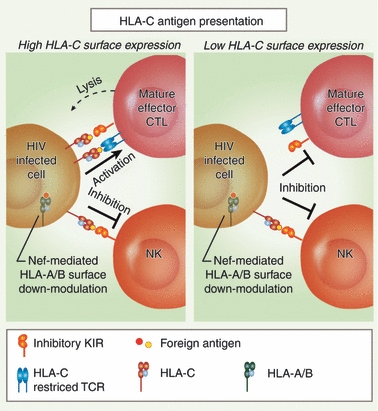Figure 4.

HLA-C surface expression and HLA-C-restricted anti-HIV cytotoxic T lymphocytes (CTLs). Left panel: In HIV-infected individuals, HLA-A and -B molecules are preferentially down-modulated by the accessory protein Nef. Relatively high levels of HLA-C molecules on the cell surface allow for presentation of HIV-derived peptides to antigen-specific CTLs. The engagement of the HLA-C-specific T-cell receptor may overcome the inhibitory signal of HLA-C interaction with killer cell immunoglobulin-like receptors (KIRs) on mature effector CTLs, allowing for efficient recognition and lysis of the infected cell. However, the remaining HLA-C also results in a potent inhibition of natural killer cell-mediated recognition and lysis. Right panel: Lower HLA-C surface expression coupled with HLA-A and -B down-modulation in the context of HIV infection may result in a decrease in efficient CTL recognition and lysis of the infected cell. The lower steady-state surface expression of HLA-C may still allow for inhibition of NK cells expressing KIRs.
